Transforming the Object of our Study: The Early Modern Sermon and the Virtual Paul’s Cross Project
John N. Wall
Scholars of early modern England have recently begun to pay more attention to sermons. (McCullough, Adlington, Rhatigan 2011). Scholars have recognized that in the sixteenth and seventeenth centuries, as Jeanne Shami has put it, sermons were “the mass media of their day,” providing their listeners with reports of “breaking news,” while satisfying “appetites for . . . entertainment, social interaction, politics, and, of course, religious education” (Shami 2011, 323). Since attendance at services of the Church of England was required by law, and sermons figured prominently in the practice of worship, they were inescapable parts of everyday life. Yet their popularity is undeniable; as many as 5,000 to 6,000 people came on their own to Paul’s Churchyard outside St Paul’s Cathedral on Sundays for additional sermons that lasted for two hours (Figure 1).
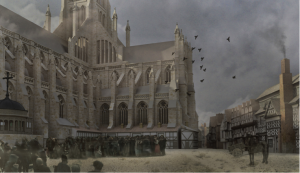
Figure 1: Paul’s Churchyard, looking west, November 5, 1622. From the visual model constructed by Joshua Stephens and Jordan Grey.
When scholars address the topic of sermons in their studies of early modern literature, however, they typically treat early modern sermons as theological essays, not as public events. Whatever the topic, whether it is the sermon’s theological content, its rhetorical structure, the style of composition, or the use of scripture, or of classical or contemporary allusions, they base their discussions on, and support their arguments with quotes from the texts, whether they survive in manuscript or printed form. They write about early modern sermons, therefore, as though the text of the sermon that comes down to us, either in manuscript or printed form, is the sermon, is the goal and culmination of the process that lies behind the production of that text (Stanwood, Strier, Shuger, Johnson). In these approaches, sermons-as-text can be read in extract, in proof-text, backwards or forwards, with sections viewed as important read repeatedly, more closely than other sections, highlighted for our attention while other sections recede from view.
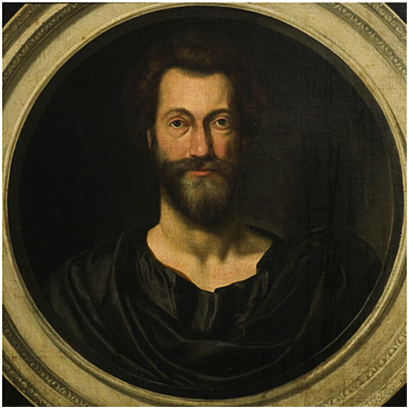
Figure 2: Oil Painting, John Donne (1573-1631), at the age of 49. Anon. British School, 1622. Image courtesy of the Victoria and Albert Museum.
John Donne, Dean of St Paul’s Cathedral from 1621 – 1631 (Figure 2), was the best-known preacher of his day, so his sermons have received the most attention among scholars. It is appropriate, therefore, that we begin reconsidering what we mean when we talk about an early modern sermon by talking about Donne’s sermons. Peter McCullough, editor of the forthcoming Oxford edition of Donne’s sermons, has started this conversation with his recent discussion of the unfolding argument of John Donne’s sermon at the funeral of Sir William Cokayne, delivered in 1626. McCullough’s discussion helps us move from thinking of the text to thinking of the performance of the text by locating this Donne sermon carefully in its context (McCullough 2011). In McCullough’s account, Donne’s sermon moves one way, from opening through development to conclusion, in a specific location and in a specific set of circumstances, an approach McCullough has refined through numerous public readings of several of Donne’s sermons.
The strength of this approach is that it situates Donne’s sermon in its immediate social, physical, and liturgical context while it asks us to attend to each section of the sermon as it comes in the text, without evasion or suppression, in the context of what precedes and follows it. My experience in working with the Virtual Paul’s Cross Project (Figure 3) has led me to consider an even more radical approach. This project, supported by a Digital Humanities Start-Up Grant from the National Endowment for the Humanities, makes it possible for us to hear, not read, John Donne’s sermon for November 5th, 1622 as it unfolds, word-by-word and moment by moment, in real time and in a digital model of the space outside St Paul’s Cathedral for which it was originally prepared.
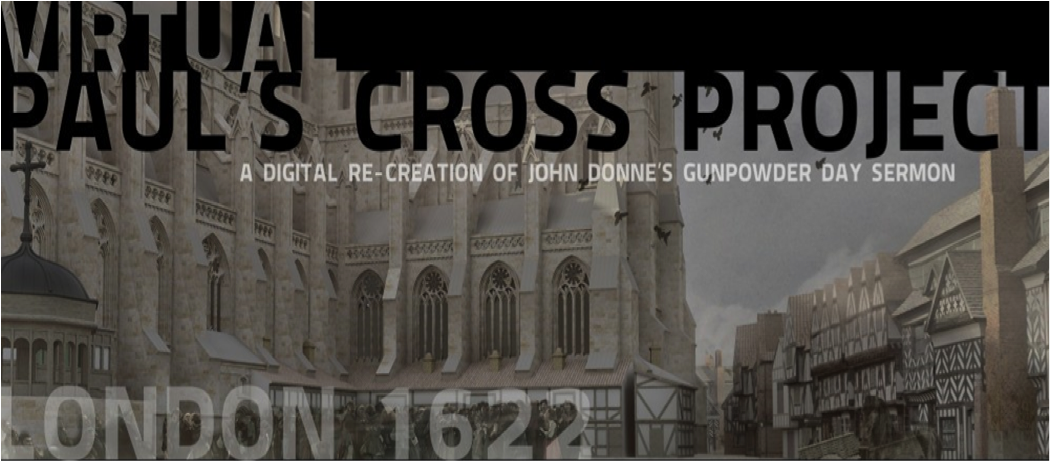
Figure 3: Image of Paul’s Churchyard, November 5, 1622. From the visual model constructed by Joshua Stephens and Jordan Grey (2012-2013).
The words the actor Ben Crystal says as he performs Donne’s sermon are the words of the surviving manuscript of this sermon (Donne 1996), but the more I have listened to his performance the more I have realized that to rediscover the sermon-as-event rather than the sermon-as-text — to glimpse the performative and participatory character of early modern preaching — involves recognizing the text that we have of the sermon as a trace of, at best a memorial reconstruction of, the sermon-as-event, rather than the sermon itself. This means we must, paradoxically, read the text both for what it tells us about the event it remembers and what it doesn’t tell us, read for clues about how this memorial reconstruction differs from the sermon-as-delivered as well as how closely it remembers that event.
The Virtual Paul’s Cross Project
To support my argument, I need to explain a bit about what we have created in the Virtual Paul’s Cross Project. This project uses 3-D visual and acoustic modeling technology to recreate as accurately as the evidence allows the experience of about 2 hours of time, from 10:00 until noon, on November 5th, 1622, in the north-east corner of Paul’s Churchyard, outside St Paul’s Cathedral in London. Users of this site can hear John Donne’s sermon for Gunpowder Day in its full 2-hour version from two different locations in the Churchyard. They can also hear portions of the sermon from eight different listening positions and in the company of four different sizes of crowd, from 500 people to 5,000 people, modeling the range of contemporary estimates of attendance at these sermons.
The Early Modern Sermon: Text or Performance
As a result of this project, I have come to view the text of a sermon not as the sermon itself, but as a trace — a very detailed trace, but a trace nonetheless — of the sermon-in-performance. The text of Donne’s Gunpowder Day Sermon, which survives in both a manuscript (Figure 4) and a printed version (Figure 5), now takes its place in the company of visual depictions of places and events, written accounts of occasions on which sermons were delivered, and remembrances of individual preachers’ styles of delivery as sources for hints and clues to help us imagine fully the sermon-as-event. All of these various traces of the event itself have been integrated into a single experiential research environment through digital modeling.
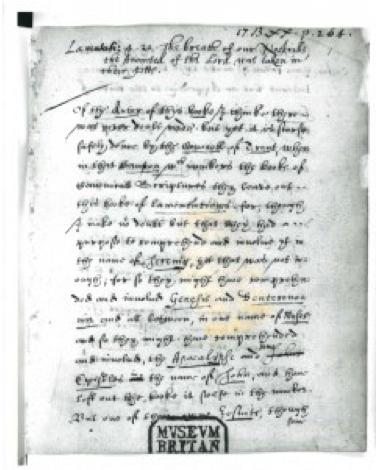
Figure 4: John Donne, Sermon for Gunpowder Day, November 5, 1622, Page One. From MS Royal. 17.B. XX. Image courtesy the British Library.
Thus the sermon-in-performance becomes the proper subject of our study, with the surviving text of the sermon now viewed as delivered in the context of an the interactive event led by a particular individual in a specific architectural space over the course of a specified period of time, in the presence of a specific gathering of listeners, in the context of a specific set of historic and cultural circumstances.
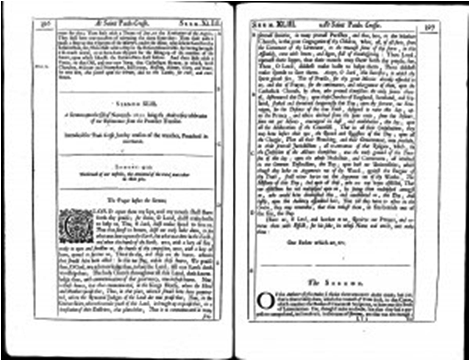
Figure 5: John Donne, Sermon for Gunpowder Day, November 5, 1622, Page One. From Fifty Sermons (London 1644).
This is a view of the sermon supported by early modern sources. As Arnold Hunt has reminded us, “’faith is by hearing’ . . . was a precept that Protestant commentators took very literally” (Hunt 22). Edward Vaughan, for example, claimed in 1617 that if one “take away the preacher take away the word, take away the word take away hearing, take away hearing take away Faith, take away Faith take away calling upon God, take away calling upon God take away salvation in Christ” (Vaughan 1617, 25-6). Donne once described the performance of an effective preacher in terms of a coordinated effort of body, feeling, and ideas, uniting “matter and manner,” the quality of the voice (“pleasant”) and personal manner (“acceptably, seasonably, with a spiritual delight”), with “a holy delight,” toward the goal of “profit” for his congregation. For Donne, God appears “to our eyes . . . by Sacraments” and “to our ears, by . . . audible means,” for “Preaching is the thunder that clears the air, disperses all clouds of ignorance” (Donne 1953-62, 4: 105).
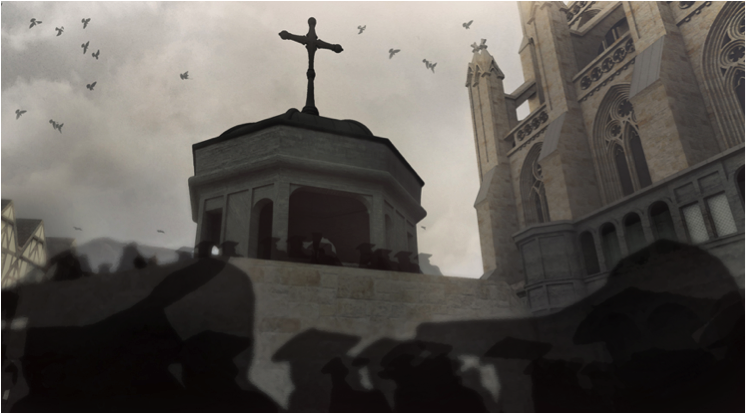
Figure 6: Image of Paul’s Cross, November 5, 1622. From the visual model constructed by Joshua Stephens and Jordan Grey.
Such language reminds us that early modern culture was a profoundly aural culture, one in which, in Carol Symes’ words, “the gesture, the posture, the sound, and the spoken word were the powerful discursive modes through which writing was publicized and . . . subordinated” (Symes 287). The post-Reformation Church of England was defined as much by a change in the practice of worship as it was about an exchange of one theological understanding for another. Public observation of the Mass celebrated in Latin was replaced by participatory involvement of a community who heard the Word read and preached in the vernacular and responded in prayer and thanksgiving.
The Book of Common Prayer’s daily and weekly round of services (which Donne echoes in his prayer before the sermon on Gunpowder Day) provided a framework for spiritual formation and preaching. In this context, Donne, as the Dean of St Paul’s Cathedral and one of the most distinguished preachers of his day, sought to engage his hearers, to change his hearers, to bring them — through both cognitive and emotional means — to amend their lives in directions set out by Donne in the sermon.
Visual and Acoustic Models
Digital modeling technology used in the Virtual Paul’s Cross Project enables us to integrate the physical traces of pre-fire St Paul’s Cathedral — measurements of the foundations and study of the surviving stones — with the historic visual record (Figures 7,8, and 9) of the cathedral and its surroundings into a highly accurate visual model of the cathedral and its churchyard (Figure 6).
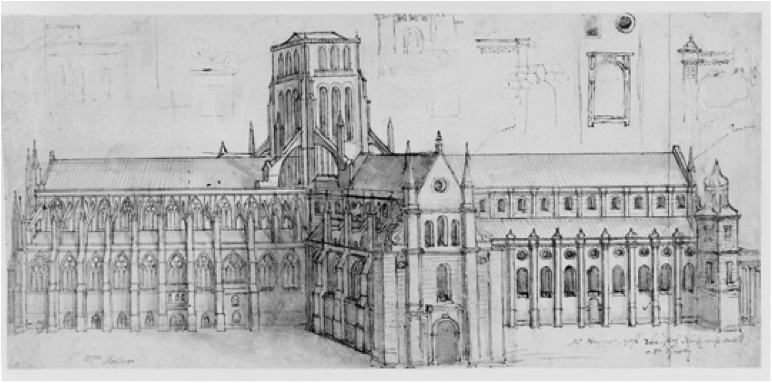
Figure 7: Wenceslaus Hollar, drawing, St Paul’s Cathedral, north side (1650′s). Image courtesy Sotheby’s, London.
Our model depicts the north-east corner of Paul’s Churchyard, including the Choir and North Transept of the Cathedral, the Paul’s Cross Preaching Station, and the buildings surrounding the Churchyard, chiefly mixed-use houses with retail book shops on the ground floor and living accommodations above. The model also includes the buildings along the streets that run alongside the northeast corner of the Churchyard, specifically Paternoster Row to the north and The Old Change Street to the east, as well as their intersection at the west end of Cheapside.
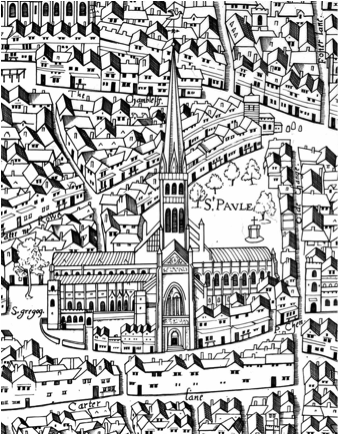
Figure 8: St Paul’s Cathedral, Detail from the Copperplate Map (1550?). Image courtesy the Museum of London.
The spaces and structures we have modeled were all destroyed by the Great Fire of London which consumed over half the city during its 5-day conflagration in early September of 1666. Digital modeling technology enables us to recreate a highly accurate visual model of this space, one that integrates into a single visual presentation all that we know or can surmise about the appearance of this long-lost space.
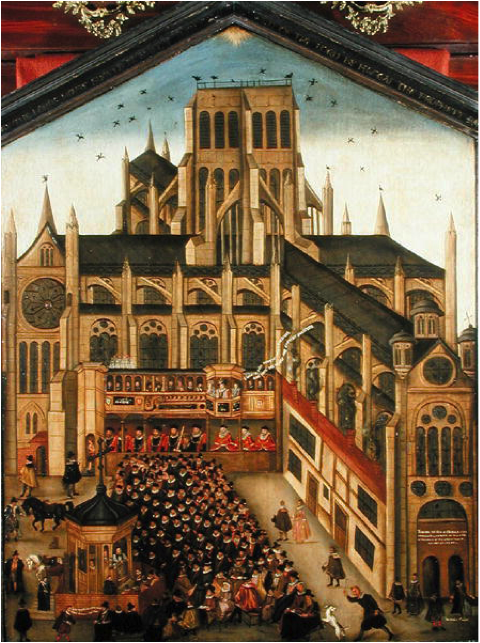
Figure 9: John Gipkin, Bishop King Preaching at Paul’s Cross before King James I. (1616). Image courtesy of the Bridgeman Art Library, New York, and the Society of Antiquaries, London.
Our visual model serves as the basis for an acoustic model that recreates the experience of sound in Paul’s Churchyard, a place with definable geometric properties and specific material surfaces. Within this model we can hear the ambient noise of horses, dogs, and birds, as well as the sound of the cathedral’s clock marking the passage of the hours and quarter-hours. We can join a range of different sizes of crowd as they gather to experience a historically faithful interpretation of Donne’s preaching style, performed by the actor Ben Crystal and based on contemporary descriptions of Donne’s capacity to engage his congregations imaginatively and emotionally, and to delight them with his wit (Figure 9).

Figure 10: Paul’s Churchyard, as seen from the Sermon House. From the Visual Model, constructed by Joshua Stephens, rendered by Jordan Grey.
The Virtual Paul’s Cross Project thus provides the opportunity to experience the phenomenon of the Paul’s Cross sermon, an occasion of outdoor public preaching at Paul’s Cross in Paul’s Churchyard in early modern London, as an event unfolding in real time, in a space modeled after the space in which it was originally delivered, in the presence of a large public gathering of people, and with at least the suggestion of the conditions and circumstances in which they gathered for its original delivery (Figure 10). As such, it enables us to identify and evaluate our understanding of the Paul’s Cross sermon as a social phenomenon, as an interactive occasion, and as a public event.
The Paul’s Cross Sermon
The Paul’s Cross sermon, delivered in the largest open-air gathering space in London, was the occasion when the English government, the official state-controlled Church of England, and the general population of London intersected. Here, every Sunday between 10:00 and noon from the early years of the sixteenth century until the middle years of the seventeenth, preachers chosen by the Bishop of London declared and defended official policies concerning religion, debated the controversies of the English Reformation, and sought to nurture the spiritual well-being of the citizens of London (Morrissey 2011).
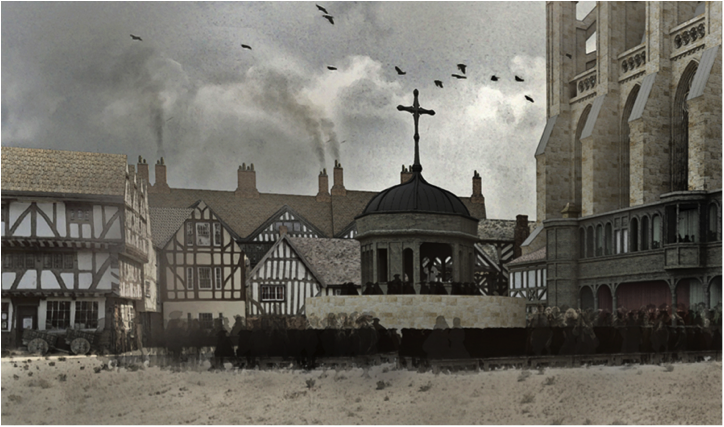
Figure 11: Paul’s Cross, from about 75 feet. From the Visual Model, constructed by Joshua Stephens, rendered by Jordan Grey.
Donne preached frequently at Paul’s Cross (Figure 11). His sermon for Gunpowder Day, November 5th, 1622, is an especially revealing example of Donne’s ability to bring multiple agendas to bear on the specific occasion of his preaching. Requested by King James I (Figure 12) to preach on this observance of Guy Fawlkes Day, Gunpowder Day, Donne had at least three specific points to make. One was to give thanks for James I’s deliverance — in Donne’s view, by divine intervention — from the plot by radical Catholics, led by Guy Fawlkes, to assassinate the King and his government by blowing up the Houses of Parliament while James was addressing them on November 5th, 1605. The second was to defend James from his peoples’ concerns about his plan to arrange an alliance with the very Catholic government of Spain, to be sealed by the marriage of Charles, the Prince of Wales, to a Spanish princess. The third was to remind his people that their king, whether they thought he was a good king or a bad king, was God’s anointed king, and so they were called to trust and obey him.
Our challenge, therefore, is to reimagine how these sermons, as social and political as well as religious gatherings, functioned to bring together church, state, and people for instruction, inspiration, and identity formation. Donne in his Gunpowder Day sermon seeks to develop a sense of English identity, in relationship to a God who delivered their king from harm, to a king whose subjects owed their obedience and patience, and to a sense of participation in a community chosen by God to have this king, and to obey him. Comparing James to the Israeli kings Josiah and Zedekiah, Donne also compares the English to the people of Israel, God’s chosen people, with whom they shared one God, a history of monarchy, and a sense of election to a common destiny with God.
Discussion of the early modern sermon thus requires that we attend to the event of the sermon, and view the text of the sermon as a bearer of traces of that event. Sermon texts from the early seventeenth century survive because they were written down after their delivery by clergy who wished to remember what they said. Even though Paul’s Churchyard was the center of the English book trade — the buildings around the north and east sides of Paul’s Churchyard all housed bookshops — sermons were rarely published. Donne, for example, published fewer than a dozen of his hundreds of sermons. Some of Donne’s fellow clergy rejected publication of sermon texts precisely because the printed version lacked the preacher’s voice and style of delivery and the ambiance of the original occasion (Rigney 2011). Only as the seventeenth century wore on would clergy begin to recognize the value of printing as a way of extending the range of their voices. Only after his death would large numbers of Donne’s sermons be published in collected editions.
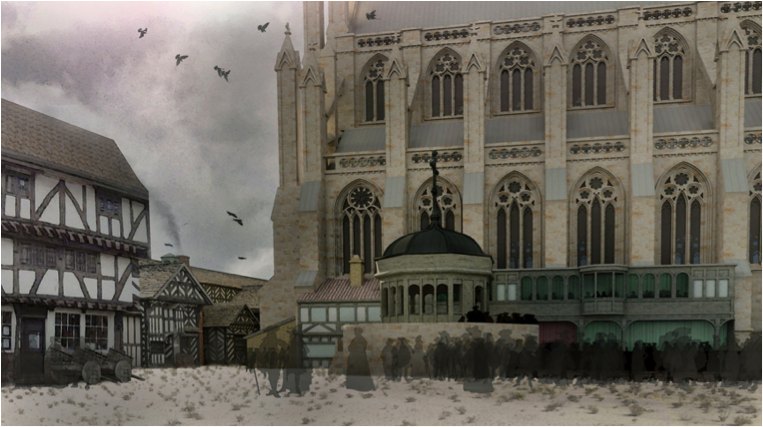
Figure 13: Paul’s Cross, from the north. From the Visual Model, constructed by Joshua Stephens, rendered by Jordan Grey.
From this perspective, the sermon texts that survive from this period are at best memorial reconstructions of the words spoken during the event. Their reliability as a transcript of what was said on the occasion of the sermon is itself a subject of inquiry. If, as we will see, these remembered words provide us with a wide range of clues to the character of their performance, as well as a fairly accurate account of what was actually said, this is due, I will argue, precisely because of early modern preachers’ placing priority of performance over publication as the goal of preaching.
What We’ve Learned: Audibility
The Virtual Paul’s Cross Project has taught us, for example, that a preacher delivering a sermon in Paul’s Churchyard could be heard from anywhere in the Churchyard (Figure 13), so long as the crowd was quiet. The space of Paul’s Churchyard, surrounded to the west and south by the cathedral itself, and to the east and north by the buildings that housed booksellers’ shops, created a kind of natural amplification system by reflecting the sound of the preacher’s voice. But this same environment amplified by echo, so the preacher could be heard and understood only if he delivered his sermon at a deliberate pace, a pace that permitted each word to be heard rather than to be muddled by the reverberation of the previous word.
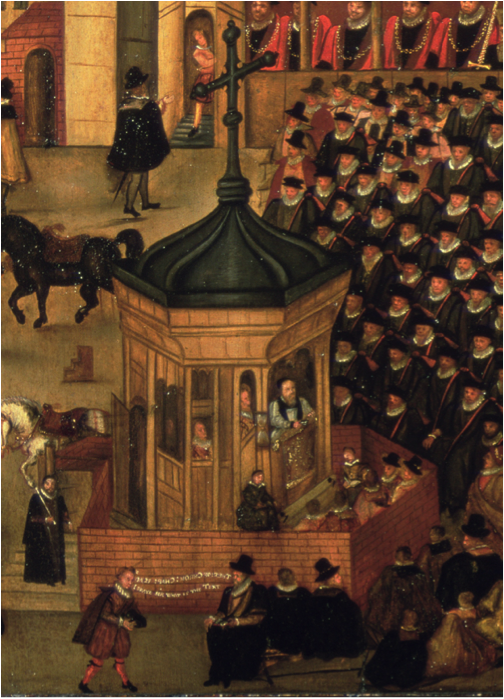
Figure 14: John Gipkin, Bishop King Preaching at Paul’s Cross before King James I, Detail. (1616). Image courtesy of the Bridgeman Art Library, New York, and the Society of Antiquaries, London.
Or, as Ben Markham, one of our acoustic engineers puts it, “[T]hanks to sound reflections from the nearby buildings, listeners at Paul’s Cross . . . at a significant remove from the speaker . . . likely perceived speech at a level as much as twice as loud as they would have were the speeches presented in an open field.” Markham also notes that “the slow cadence and emphasis of certain phrases helps to improve intelligibility by overcoming the effects of reverberation, ambient noise, and listeners’ imperfect attention” (Markham, Acoustics at Paul’s Cross). This style of delivery is exemplified by the approach taken by the actor Ben Crystal in his performance of Donne’s Gunpowder Day sermon for November 5th, 1622 (go to http://vpcp.chass.ncsu.edu/audibility/ or http://vpcp.chass.ncsu.edu/listen-the-sermon/ or http://vpcp.chass.ncsu.edu/listen-interaction/ to experience this).
A deliberate pace of speaking thus would seem to be a necessary characteristic of Donne’s delivery — and the delivery of all preachers — at Paul’s Cross (Figure 14). This was a totally unexpected outcome of our work with the Virtual Paul’s Cross Project, an outcome at once entirely logical and understandable and at the same time entirely unsupported by contemporary accounts of early modern preaching styles. But this was only the beginning of a process of thinking through our understanding of the early modern sermon as we gained more experience listening to the sermon through the acoustic model.
What We’ve Learned: Improvisation
The Paul’s Cross sermons — while they were planned carefully in advance — actually were composed in the process of delivery by a preacher working from notes who faced a congregation gathered in the open air and surrounded by a host of distractions, including the birds, the dogs, the horses, the bells, and each other. This means he could adjust his sermon content to respond to the behavior of his congregation, revising in process, shortening or expanding elements of his argument as occasion seemed to demand. While the early modern preacher had developed a capacity for working within an implicit framework of organizational structure and dramatic presentation so the content of his delivery was logically coherent and supported by his delivery, he was chiefly interested in engaging with his congregation emotionally as sell as cognitively, emphasizing the preacher’s capacity to move as well as to teach.
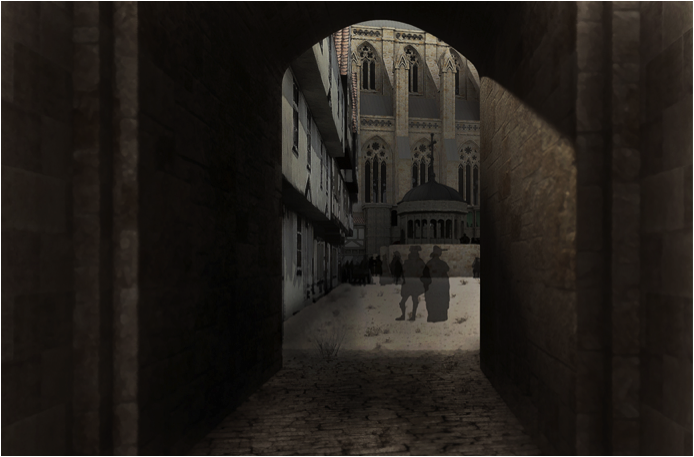
Figure 15: Paul’s Cross, from the north, seen through Paul’s Gate. From the Visual Model, constructed by Joshua Stephens, rendered by Jordan Grey.
This improvisatory dimension to early modern sermon performance is reflected in Donne’s sermon for Gunpowder Day in 1622 (Figure 15). For example, Donne clearly departs from the organizational plan he lays out for the sermon early on in its progress. Donne starts with a two-part division of his text, and a three-part plan for his sermon organization.
When this person therefore was fall’n into the pitts of the Enemie, the Subiect laments; but this lamentinge, which was because he was falln, implyes a deliverance, a restitution; he was falln, but he did not ly there; so the text which is yit a lamentation, growes an howre hence to be a congratulation; and then we shall see, that whosoeuer hath lamented a danger and then congratulated a deliverance, he will provide against a relapse, a fallinge againe into that or any other danger, by all meanes of sustayning the Kingdome, and the King, in safety, and in honor (Donne 1996, 61-63).
Donne notes that “this lamenting . . . implies a deliverance,” so “the text which is yet a lamentation growes an howre hence to be a congratulation” and will conclude with a provision “against a relapse.” While the sermon does end with some advice about how to maintain the kingdom, and while it does begin with lament for the disobedience of God’s people, and by extension, James’ subjects who sought to blow him up, the sermon never gets — at the half-way point (“an howre hence”) or anywhere else — to the level of celebration.
While one could easily imagine a Gunpowder Day sermon filled with celebration for James’ delivery from the plans of Guy Fawlkes and his fellow plotters, this sermon instead — “an howre” into it — is devoted to a discussion of James’ importance to his subjects — “he is the breath of our nostrils,” etc. — a lecture that leads to affirmation of his subjects’ duty to obey him, whether or not they agree with him. Whether Donne promised “celebration” at the beginning to give his audience something to look forward to while all the time planning to lecture them on obedience, or whether in the course of delivering the sermon he thought better of his original plan and decided, given the circumstances, that he ought to venture into an affirmation of James’ importance to his subjects, we at this stage cannot say. We do, however, need to attend to these internal accounts of what to expect to hear in the course of the sermon so that we can notice whether, in these sermons, such promises are kept or not, and how the course of the sermon changes from its announced path, if in fact it does.
The Text as Trace
The rest of this essay will consist of several preliminary approaches to the question of text as trace. In the course of developing the style of sermon delivery one finds on the Virtual Paul’s Cross Project website, I have had to make decisions about how passages of the sermon were to be delivered, how we imagined the unfolding of the events that surrounded the delivery of the sermon, and how we imagined interactions between the text in delivery and ambient noise both predictable like the ringing of the clock bell and randomly occurring like the sounds of birds, horses, and dogs (Figure 16). In each case, these decisions led me away from the text of the sermon as recorded by Donne after the day of delivery and toward the sermon as a performance by Donne unfolding in the context of the place and occasion that define the event itself.
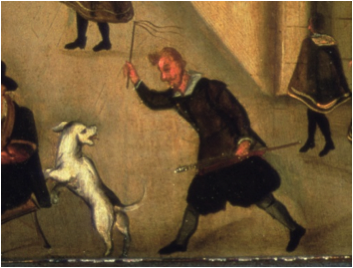
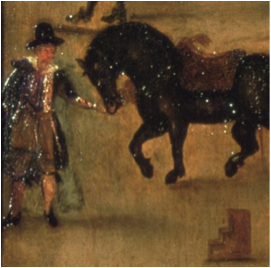
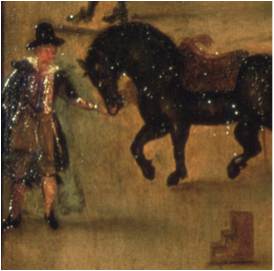
Figure 16: Details, John Gipkin, Painting of Paul’s Cross (1616). Images courtesy of the Bridgeman Art Library, New York, and the Society of Antiquaries, London.
Hence the task I have learned has been to identify ways of reading the texts of sermons that treats them as sources for glimpsing the preacher in performance. For instance, in Donne’s sermon for Gunpowder Day, November 5, 1622 (the sermon as delivered is featured on the Virtual Paul’s Cross website), there occur in the course of the sermon text two instances of sentence fragments. These two instances are unique in the course of this sermon and thus invite discussion of their role in the text.
Working with our Project’s website has taught me to talk about the sermon in terms of time rather than space. Therefore I will refer to the location of these sentence fragments in terms of the time of delivery rather than the spatial metaphor of “one-quarter of the way through the sermon.” The first of these fragments comes about half an hour into the recording of the sermon, in the context of Donne’s discussion of Israel’s relationship to God at the time of the prophet Samuel, and especially around the question of kingship.
The people of Israel demand — through Samuel — that God change their form of governance, shifting from a system of judges to a monarchy. God resists, the people insist, and God finally gives in, appointing Saul to serve as their first king. Donne is defending monarchy in this sermon, especially the monarchy of James I, so he is not going to question the appropriateness of Israel’s demand for a king, only its timing. His concern is, therefore, with the attitude of the people toward God; they demand that God give them a king before God is ready to do so (Figure 17).
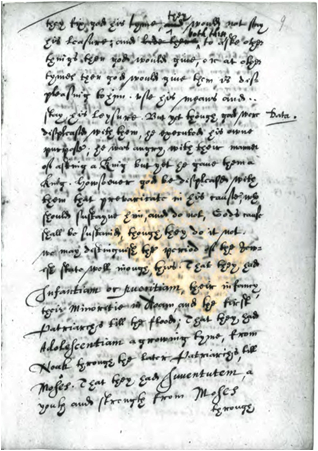
Figure 17: John Donne, Sermon for Gunpowder Day, November 5, 1622, Page 16. From MS Royal. 17.B. XX. Image courtesy the British Library.
The manuscript text reads:
They would not trust Gods meanes, theire was their first fault; And then though they desird a good thing, and intended to them, yet they fix God his tyme, they would not stay his leasure; and both these, to aske other things then God would giue, or at other tymes then God would giue them is displeasing to him. use his means and stay his leysure. But yet though God were displeasd with them, he executed his owne purpose; he was angry with their manner of asking for a King but yet he gaue them a King. Howsoeuer God be displeasd with them that prevaricate in his cause, who should sustayne him, and do not, Gods cause shall be sustaind, though they do it not (Donne 1996, 75-77).
The sentence fragment is “use his means and stay his leisure.” If we consider it as part of the finished, delivered, sermon, it appears redundant, echoing, for no apparent reason what Donne has already said in the preceding sentence (Figure 18).

Figure 18: John Donne, Sermon for Gunpowder Day, November 5, 1622, Page 16, detail. From MS Royal. 17.B. XX. Image courtesy the British Library.
If, on the other hand, we consider these seven words as constituting a surviving trace of the notes for the sermon that Donne took into the pulpit with him, notes that Donne worked from when he delivered the sermon, then we glimpse before us something of Donne’s practice in preaching, glimpse two or perhaps three different stages of Donne’s sermon construction, the one the note “use his means and stay his leisure” and the other the sentence (or the sentence as Donne remembered it when he wrote out the sermon) he made from those notes in the process of sermon delivery:
They would not trust Gods meanes, theire was their first fault; And then though they desird a good thing, and intended to them, yet they fix God his tyme, they would not stay his leasure; and both these, to aske other things then God would giue, or at other tymes then God would giue them is displeasing to him. . But yet though God were displeasd with them, he executed his owne purpose; he was angry with their manner of asking for a King but yet he gaue them a King. Howsoeuer God be displeasd with them that prevaricate in his cause, who should sustayne him, and do not, Gods cause shall be sustaind, though they do it not (Donne 1996, 161-65).
The other sentence fragment comes an hour and forty-five minutes into the sermon. At this point, Donne is recounting how both good kings like Josiah and bad kings like Zedekiah can run into challenges, can be “taken in their pits,” echoing Lamentations 4:20, Donne’s text for the occasion (Figure 19).
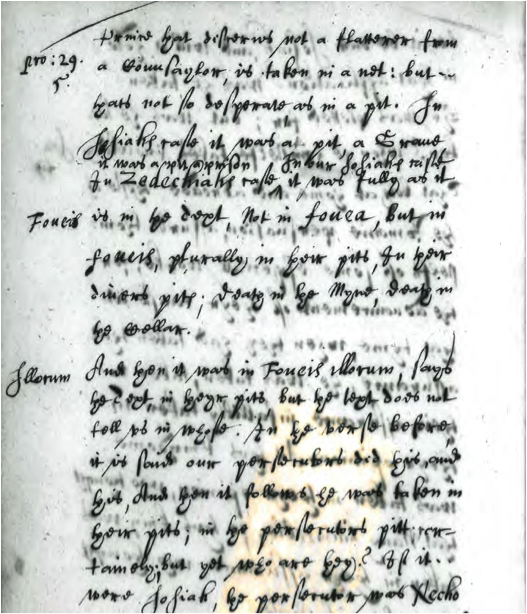
Figure 19: John Donne, Sermon for Gunpowder Day, November 5, 1622, Page 42. From MS Royal. 17.B. XX. Image courtesy the British Library.
The manuscript text reads:
As this kingdome was taken in theyr opinion, who thought that Nauy inuincible, so this king was taken in theyr assurance, who thought that plot infallible. He was taken, and in foueis, in pitts, says the text. If our first translation would serve, the sorrow were the lesse, for there it is, he was taken in their Net; now, a man that flattereth spreadeth a Net; a Prince that discerns not a flatterer from a Counsaylor, is taken in a net: but thats not so desperate, as in a pit.
In Josiahs case it was a pit, a Graue, in Zedechiahs case, it was a pit, a prison. In our Josiah’s case, it was fully as it is in the Text, not in fouea, but in foueis, plurally in their pits, in their diuers pits; Death in the Myne, Death in the Cellar.
And then it was in Foueis illorum; says the Text, in their pits, but the text does not tell vs in whose. In the verse before, it is said our persecutors did this, and this, and then it follows he was taken in their pits; in the persecutors pitt certainely; but yet who are they? If it were Josiah, the persecutor was Necho king of Egipt, for from his army Josiah receyud his deaths wound; If it were Zedechiah, the persecutor was Nebuchadnezzar, king of Babilon, for he carried Zedechiah into Captiuity: Certenly the Holy ghost knew well inough, and could haue spoke playne, whose these pitts were; but it pleasd him to forbear Names (Donne 1996, 161-65).
The sentence fragment is “Death in the Myne, Death in the Cellar,” words linking the fates of Josiah (who was killed in battle and buried), Zedekiah (who died in prison in Babylon) , and James I (who should have been killed by the explosion of gunpowder in the cellar of the Houses of Parliament).
Again, we have two (or three stages) of sermon construction imbedded in the text, the note that Donne took with him into the pulpit, and the words that Donne remembered having spoken in the process of working in his sermon performance from those notes to their elaboration in the words of Donne’s text.
What We’ve Learned: Elements of Performance
There are also ways of identifying elements of performance in the texts of these sermons. We can approach this by trying to apply accounts of Donne’s preaching style to the texts themselves. In developing the various styles of delivery to be used by the actor Ben Crystal in his delivery of different parts of Donne’s sermon, Ben and I reviewed contemporary accounts of Donne’s preaching. For example, Donne is remembered for his wit, his eloquence, his capacity to express and arouse feeling, to elevate, to captivate, to motivate. Izaak Walton, in his biography of Donne, especially remarks on Donne’s capacity to communicate with the minds and feelings of his listeners, to teach and to move them:
carrying some, as St. Paul was, to Heaven in holy raptures, and inticing others by a sacred art and Courtship to amend their lives; here picturing a vice so as to make it ugly to those that practised it; and a vertue so, as to make it be loved even by those that lov’d it not, and all this with a most particular grace and an unexpressable addition of comelinesse (Walton 1658, 47-48).
As an example of Donne’s ability to evoke emotional responses in his hearers, Walton cites Donne’s sermon preached shortly after his wife’s death, in which, Walton says, Donne’s performance “did so work upon the affections of his hearers, as melted and moulded them into a companionable sadness” (55).
Comments by others of Donne’s contemporaries expand on Walton’s basic claims. I’ll cite a few examples (all of these are collected here). Jasper Mayne, writing while a student at Christ Church, Oxford, says that Donne, with his words, “could [so] charme [his] audience,/ That at [his] sermons, eare was all our sense” and with his “looke, and hand” and “speaking action” could give them “More Sermon, then some teachers used to say” (Mayne 1912, 55-60). John Chudleigh wrote that Donne “did not banish” his wit when he took orders, “but transplanted it;/Taught it his place and use, and brought it home/To Pietie, which it doth best become” (Chudleigh 1912, 14-16). Daniel Darneley’s Latin elegy for Donne, here translated by my colleague Zola Packman, says that he employed “his eyes, his hands, his face” (Darneley 1912, 41) and held “hearts, eyes, and men” (45) while he “reveal[ed] to the commoners/ Mysteries not earlier entrusted to them and not yet understood” (47-48) and “with changed manner and form of speaking/ Treated of sorrowful things/ . . . . /Then you would see them all give a groan” (50-53).
Such comments reminded us as we planned the sermon recording that Donne’s preaching was not the univocal delivery of a lecture to a passive quiet, cognitively attentive audience but an interactive performance delivered on a specific occasions for specific congregations, in a format that was shaped by performer’s and hearers’ expectations about the event, and by their interactive participation in the event. Donne preached for an audience well-experienced in sermon-going, with a high regard for the quality of performance, for the techniques of delivery, the techniques of text-handling, of division and application. Holding their attention must have been a major concern, both through cleverness of content and through skillful delivery, skillful performance of the roles of priest, prophet, spiritual guide, interpreter, model and enabler of transformation.
Donne emphasizes the liveliness of his congregations, and thus the interactive character of early modern preaching. In his account of a sermon at St Paul’s Cathedral, Donne remembers calling attention to “those often periodicall murmurings, and noises, which you make, when the Preacher concludeth any point; for those impertinent Interjections swallow up one quarter of his houre, and many that were not within distance of hearing the Sermon, will give a censure upon it, according to the frequencie, or paucitie of these acclamations.” (Donne 1953-62, 10: 133-34) Donne here sounds annoyed at such congregational responses; at the same time, he reminds us of the challenges a preacher faced in engaging, and sustaining, his congregations’ attention throughout the one- or two-hours traffic of the pulpit (Figure 20).
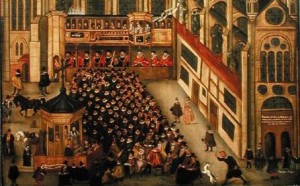
Figure 20: Detail, John Gipkin, Painting of Paul’s Cross (1616). Images courtesy of the Bridgeman Art Library, New York, and the Society of Antiquaries, London.
We have tried to capture the experience of a lively and responsive congregation in the recordings heard on the Paul’s Cross website. There are several different recordings of crowd response in the website’s databases; as the sound of Ben Crystal’s voice becomes more energetic, the crowd responds more energetically. To create this interaction, we reviewed the text of Donne’s sermon to see which manner of delivery might well fit the sermon’s different sections. At the beginning of his sermon for Gunpowder Day in 1622, for example, Donne declares his text as the 20th verse of the 4th chapter of the Book of the Lamentations of Jeremiah. Instead of starting off with an explication of this text, however, Donne begins by evoking Protestant claims that Catholics do not understand the Bible:
Of the Autor of this booke I thinke there was never doubt made. But yet it is scarse safely donne by the Councell of Trent, when in that Canon which numbers the books of Canonicall Scriptures they leave out this booke of Lamentations. For, though I make no doubt but that they had a purpose to comprehend and inuolue yt in the name of Jeremy, yet that was not inough; for so they might haue comprehended and inuolud Genesis and Deuteronomie and all between, in one name of Moses: and so they might haue comprehended and inuolud, the Apocalypse and some Epistles in the name of John, and haue left out the booke it selfe in the number (Donne 1996, 45).
Having claimed that Catholics do not know what books are in the Bible, he then points out that they are not united in their (contrary) understanding, nor do they know how to count.
But one of their owne Iesuits . . . determins for all that Canon, that it is a distinct booke; Indeed, if it were not, the first Chapter would haue been calld the 53th of Jeremy: and not the first of the Lamentations. But that which giues most assurednes to it, is, that in divers Hebrew Bibles it is placd otherwise, then we place it; not presently after the prophecy, of Jeremy though it were ever vndoubtedly receyud to be his (Donne 1996, 45-47).
This passage — and others like it in the sermon — may not seem funny to us, but they are witty and attention-getting. Further, they link preacher and congregation into a single gathering by inviting the members of the crowd gathered in Paul’s Churchyard to join Donne in a common attitude of derisive superiority toward their Catholic opponents (Figure 21).
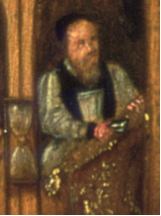
Figure 21: Detail, John Gipkin, Painting of Paul’s Cross (1616). Images courtesy of the Bridgeman Art Library, New York, and the Society of Antiquaries, London.
Other passages clearly lend themselves to more emotionally expressive styles of delivery. Around 45 minutes into the sermon, for example, Donne is describing the Gunpowder plot, the plans Guy Fawlkes and his fellow conspirators had for James and his family and the members of Parliament:
What they did historically we know: They made that House which is the hyue of this kingdome, from whence all her Hony comes, that House, where Justice herselfe is conceyud, in their preparing of good laws, and inanimated and quickned and borne by the Royall assent there giuen, they made that whole house, one Murdring peece: and hauing put in theyr powder, they chargd that peece with Peers, with people, with Princes, with the King, and ment to discharg it vpward at the face of heauen, to shoote God at the face of God, Him, of whome God had sayd, Dij estis, you are gods, at the face of that God who had said so: as though they would haue reprochd the God of heauen, and not haue been beholden to him for such a king, but shoote him vp to him and bid him take his king againe, for Nolumus hunc regnare, we will not haue this king to reigne ouer vs (Donne 1996, 95-97).
One can easily imagine Donne’s intensity of delivery at this point in the text; we have tried to use the Virtual Paul’s Cross Project to suggest this intensity in Ben Crystal’s performance of this passage. We have also tried to suggest how a crowd responding emotionally to an emotionally engaged preacher might have responded to his passion. Other sections of this sermon — the more instructional ones, or those that summarize the organizational structure of the sermon, or the more lyrical, exhortatory passages — clearly call for tones of voice and styles of delivery different from the more emotional styles of delivery we used for the passages that call for such energy. Transitional and organizational passages call for a delivery that is clear and reassuring; the lyrical passages call for a style that evocative and welcoming, and we have made it so.
One of the major sources of discovery for me, as I have developed and grown familiar with the website, is the consideration of the challenges posed for the preacher by random or predictable changes in the sonic characteristics of ambient sounds. I believe sermons in performance were responsive to changing events in the soundscape of early modern London. To conclude this paper, I will consider one of these, the periodic — and therefore predictable — sound of time’s passage.
Thanks to Tiffany Stern’s recent research, we know that part of the soundscape of early modern London was the sound of the bell at St Paul’s, activated by a clock mechanism, that rang on the quarter-hours and hours of each passing day (Stern 2012). English cathedrals in the sixteenth-century are known to have mechanical clocks that recorded time by striking bells; one of these survives at Salisbury Cathedral (Maltin and Dannemann 2013). The clock at Salisbury had no face; the ringing of a bell was its sole means of communicating the time. The sounding of this clock/bell was not discretionary. It could not be stopped and started again without disrupting its accuracy as a timepiece.
Stern’s research into the ringing of church bells in early modern London has taught us that St. Paul’s Cathedral had such a clock, and that the clock at St. Paul’s Cathedral rang on the quarter hour as well as on the hour, marking the passage of time in fifteen-minute increments. We have incorporated into the acoustic model the sound of a struck bell ringing on the hour and the quarter hour. This addition to the soundscape of the acoustic model has raised, however, the question of how the preacher dealt with the bells. He either talked over them (or tried to) or paused when they rang. The bells must have been loud enough to be heard over a good bit of London; that would have been part of the cathedral’s role as center of city life, as focus of the community’s attention, as marker, and organizer, of the passage of time in human affairs.
It seems unlikely, therefore, that the preacher could have talked over them. So, he paused. The pause at fifteen minutes past the hour would have been fairly brief, but it would have gotten longer with each passing quarter hour. The pause on the hour, at 11:00 a.m., would have been of a significant length, about a minute.
The length of the pause required to prevent the sound of his voice, hence the content of his sermon, from being obscured by the sound of the bell, however, means that Donne had options about how to deal with this inevitable but also predictable interruption. The sound of the bell would have been an interruption, coming at some otherwise random moment in the unfolding of the sermon. It would have been a pause to be dealt with in some fashion, otherwise Donne’s congregation’s attention could wander, perhaps causing them to lose track of where the preacher was in the unfolding of his argument when the interruption began. Donne could try to ignore this pause, resuming his delivery of content when the interruption was over where he left off when the interruption began; he could also do something when beginning again to refocus the congregation’s attention, calling them back to the task at hand and perhaps reminding them what was being said at the beginning of the tolling.
Traces of such accommodations of time’s passage in the texts of Donne’s sermons are well worth looking for, as are signs of yet another possibility, that the predictable, and hence anticipatable, interruption by the bell every fifteen minutes could be regarded by Donne not just as an annoyance to be accommodated but an opportunity to be incorporated into his delivery. With planning, the tolling of the bell could be an opportunity for Donne to complete a thought, then treat the bell as an underlining of that point, then treat the pause created by the bell as a chance to catch his breath, perhaps take a sip of the wine we are told preacher’s kept in the pulpit at Paul’s Cross, and then begin the next section of his sermon afresh.
Preachers did have access to a dependable marker of the passage of time, an hourglass positioned on a stand next to the pulpit, so that the preacher — and his congregation — could see clearly the passage of the sand in the glass marking the passage of the time of the sermon. The routine for the preacher at the beginning of his sermon was to deliver an opening prayer, to declare the text from the Bible he was going to preach about in his sermon, to turn the hourglass to start the flow of sand, and then, but only then, to start his sermon.
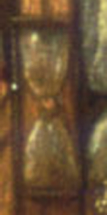
Figure 22: Detail, John Gipkin, Painting of Paul’s Cross (1616). Images courtesy of the Bridgeman Art Library, New York, and the Society of Antiquaries, London.
The purpose of the hourglass (Figure 22) was, after all, to make the preacher accountable to his congregation for the length of his sermons; it served as a trace of the passage of the time allocated to a sermon visible both to the preacher and to the congregation. Robert Chambers, in his Book of Days, tells us that the “Hour-glass that hangeth by the pulpit where the preacher doth make a sermon” was there so that the preacher “may know how the hour passeth away.” Congregations assumed an unspoken contract between them and the preacher, when “having named the text [he] turned up the glass”; “if the sermon did not last till the sand had run down, it was said by the congregation that the preacher was lazy; but if, on the other hand, he exceeded this limit, they would yawn and stretch themselves till he had finished” (Chambers 1869, December 18).
For Donne to be able to incorporate the cathedral clock’s record of the passage of time into the structure of his sermon, he would have needed to be very good at keeping track of time while preaching. He would need to be able to interpret the level of sand in the hourglass that tracked the progress of his allotted time sufficiently well to anticipate the approaching end of a fifteen-minute time period, conclude a section of his sermon just in time for the bell, then be ready to launch into the next section as the echo of the bell’s tolling faded away. We have evidence from other sermons that Donne was in fact, able to organise the structure of his sermon around the movement of time so that the content of his sermon and the time of its delivery coincide in ways that reinforce the experience of his preaching.
In his sermons delivered at the Chapel Royal on February 11, 1627, and again on February 29, 1628, for example, Donne planned his delivery so that he ran out of his allotted time just before he ran out of content (Wall 2007). In 1627, describing the everlastingness of God’s justice, Donne asserts that the news is grim: “as long as his eternity lasts . . . God shall never see that soul, whom he hath accurst, delivered from that curse, nor eased in it.” And just at that moment, he punctuates his point by drawing attention to the hourglass that has been marking the passage of time during the course of his preaching and informing his congregation that he is out of time:
But we are now in the work of an houre, and no more. If there be a minute of sand left, (There is not) If there be a minute of patience left, heare me say, This minute that is left, is that eternitie which we speake of; upon this minute dependeth that eternity (Donne 1953-62, 7: 368).
Donne says, in effect, that he is now living on borrowed time as a preacher, able to continue only in hope that there is left for him “a minute of” his congregation’s “patience.” This precarious position is, however, one he shares with his congregation, for they, too may be out of time as well, for “this minute makes up your Century, your hundred yeares, your eternity, because it may be your last minute” (Donne 1953-62, 7: 368; See also Wall 2007). Donne’s congregation, presumably, agreed to an extension of Donne’s contract, for the text of this sermon continues for three more pages, and the moment of patience he has successfully negotiated from his congregation becomes an opportunity for Donne to bring the sermon to a dramatic — and now positive, and hopeful, and celebratory — close. “[B]e this your Peace,” Donne says, “[T]o know [that] God hath laid the whole curse belonging to us upon him. . . this glorious Sonne of God . . . that hangs upon the Crosse” (1953-62 7: 369).
In 1628, he again used the same device. Approaching the end of a sermon on the relationship between sleep and death, Donne planned his conclusion, once more, to involve running out of time, out of sand, and needing to ask for an extension of his contracted allotment of time:
Now of this dying Man, that dies in Christ, that dies the Death of the Rghteous, that embraces Death as a Sleepe, must wee give you a Picture too. There is not a minute left to do it; not a minutes sand; Is there a minutes patience? (1953-62, 8: 190)
In both these cases Donne was able to incorporate the mutually agreed-upon conventions of time for the duration of a sermon into his sermon’s argument, entwining his theological argument into his interactions with his congregation around the question of time, sand, and the passage of time. He shifts the news from bad to good only after asking for and receiving from them the gift of more time, putting himself at their mercy even as they are at God’s mercy, thus demonstrating Donne’s skill at keeping time while preaching, since the whole point of both these sermons depends on Donne’s ability to bring his hour-long argument to just the right place at the precise moment when the sand has run through the glass. But the effectiveness of his argument also depends on the responsiveness of his congregation, on their willingness after an hour of preaching to grant him mercy, to extend to him more time to shift from bad news to good. In other words, the impact of this sermon is dependent not just on Donne’s performance, delivering the word to a passive audience, but to active collaboration between preacher and congregation.
The evidence of Donne’s practice in these two sermons suggests that Donne may well have been able to track the passage of time, presumably by monitoring the movement of sand through the hourglass standing next to him in the pulpit (Figure 21) with sufficient accuracy to work the sound of the clock bell striking the quarter-hours and the hours into the progress of his sermon. Donne would have been aided in doing this by the fact that he was preaching this two-hour-long sermon from notes rather than from a fully-written-out text and was able, therefore, to adjust the time of delivery to fit the time available to him. By either reducing or expanding the number of words he used, or speeding up or slowing down the pace of his delivery, he could bring a major point to closure just in time for the bell to ring, and to reinforce his point, then move on to his next point when the tolling of the bell had passed.
As a result of these considerations, when I listened to the extended recordings of Donne’s Gunpowder Day sermon on the Virtual Paul’s Cross website to identify where in the course of the recording I was going to locate the sound of the bell tolling the time, I started with the assumption that I would insert the appropriate number of tolls of the bell every fifteen minutes of recorded time. I was struck immediately with how arbitrary this was, and what a challenge to the preacher’s skill in gaining and holding his congregation’s attention would be constituted. Supported by this kind of evidence, the sermon recordings on the Virtual Paul’s Cross website bend the time of the recording to fit the time of delivery.
The process of reconceiving the texts of early modern sermons as providing traces of their performance is just beginning. Essential to that process is the need to view the Paul’s Cross sermon as a collaborative creation, two-hours-traffic upon the Churchyard, a conversation between preacher and congregation, with its own architecture of space and time and its own distribution of roles and parts, which, if effective, left no one unchanged or unformed by the experience. We also know that Donne preached for an audience well-experienced in sermon-going and with a high regard for the quality of performance. Holding their attention must have been a major concern for one performing the roles of priest, prophet, spiritual guide, interpreter, model and enabler of transformation.
The fact that Donne did not read his sermons as one would a formal lecture, but performed them as one would a public oration, or, perhaps better, as one would perform a character or a role in a play, reminds us that Donne’s preaching took place within the context of a tradition of practice. This tradition was informed by manuals of oratory that defined the role of the preacher as a social and professional role in relationship to other roles played by members of his congregation. As I noted earlier, his sermons were performed from notes that guided his delivery, so, while the structure of the sermon was worked out in advance, the actual words were improvised in process, responsive to external elements like the regular sounding of the clock bell or the irregular responses of the congregation to this or that point, or gesture, or distinctive passage.
Preachers of early modern sermons believed their performances had the potential to change their participants, to — from a pragmatic perspective — provide an entertaining way to spend time on a Sunday morning, create an occasion for a large social gathering with one’s neighbors, or advance a clerical career (Hunt 2011, 60-116). This occasion could also provide — from a theological perspective — an occasion that could change lives, advance the general welfare, promote social cohesion (especially support for the monarchy), and open the way to eternal life. By considering sermons as performances, and the texts that come down to us as providing traces of those performances, we can glimpse more fully how they might have played the role in early modern England for which their practitioners aspired.
North Carolina State University
Bibliography
Azevedo, Matt, Ben Markham, and John N. Wall. 2013. “Acoustical archaeology–Recreating the Soundscape of John Donne’s 1622 Gunpowder Plot Sermon at Paul’s Cross.” Acoustical Society of America: Proceedings of Meetings on Acoustics.
Chambers, Robert. 1864. The Book of Days.
Chudleigh, John. 1912. “On Dr. John Donne, late Dean of S. Paules, London.” 2 vols. In H. Grierson (Ed.), The Poems of John Donne (pp. 394-95). Oxford: Oxford University Press.
Cockayne, Emily. 2007. Hubbub: Filth, Noise and Stench in England. New Haven: Yale University Press.
Darneley, Daniel. 1912. “In obitum venerabilis viri Iohannis Donne.” 2 vols. In H. Grierson (Ed.), The Poems of John Donne (pp. 390-92). Oxford: Oxford University Press.
Donne, John. 1996. John Donne’s 1622 Gunpowder Plot Sermon: A Parallel-Text Edition. Ed. Jeanne Shami. Pittsburgh: Duquesne University Press.
—. 1953-62. Sermons. Eds. G. R. Potter and E. Simpson. 10 vols. Berkeley: University of California Press.
Dugdale, William. 1658. History of St. Paul’s Cathedral. London: Thomas Warren.
Gurr, Andrew. 2004. Playgoing in Shakespeare’s London. Cambridge: Cambridge University Press.
Hiltner, Ken. 2009. “Renaissance Literature and Our Contemporary Attitude toward Global Warming.” Interdisciplinary Studies in Literature and the Environment 16: 429-44.
Hunt, Arnold. 2011. The Art of Hearing: English Preachers and their Audiences, 1590-1640. Cambridge: Cambridge University Press.
Jenner, Mark S. R. 2011. “Follow Your Nose? Smell, Smelling, and Their Histories.” American Historical Review 116: 335-51.
Jewel, John. 1842. The Zurich Letters, AD 1558-1579. 2 vols. Edited by Hastings Robinson. Cambridge: Cambridge University Press.
Johnson, Jeffrey. 1999. The Theology of John Donne. Cambridge: Brewer.
Keene, Derek, Arthur Burns, and Andrew Saint, eds. 2004. St. Paul’s: The Cathedral Church of London 604-2004. New Haven: Yale University Press.
Kirby, Torrance, ed. 2013. Paul’s Cross and the Culture of Persuasion in England, 1520–1640. Leiden: Brill.
MacLure, Millar. 1958. The Paul’s Cross Sermons 1534–1642. Toronto: University of Toronto Press.
Maltin, Michael and Christian Dannemann. 2013. Dating the Salisbury cathedral clock. ClockNet UK.
Markham, Ben. Acoustics at Paul’s Cross. Virtual Paul’s Cross Project.
Mayne, Jasper. 1912. “On Dr Donnes Death: By Mr. Mayne of Christ-Church in Oxford.” 2 vols. In H. Grierson (Ed.), The Poems of John Donne (pp. 382-384). Oxford: Oxford University Press.
McCarty, Willard. 2005. Humanities Computing. New York: Palgrave Macmillan.
McCullough, Peter, Hugh Adlington, and Emma Rhatigan, eds. 2011. The Oxford Handbook of the Early Modern Sermon. Oxford: Oxford University Press.
McCullough, Peter. 2011. “Preaching and Context: John Donne’s Sermon at the Funerals of Sir William Cokayne.” In McCullough, Adlington, and Rhatigan (Eds.), The Oxford Handbook of the Early Modern Sermon (pp. 213-276). Oxford: Oxford University Press.
Meyer, Paul. 2013. “Shakespeare and Original Pronunciation.” Paul Meyer Dialect Services: Accents and Dialects for Stage and Screen.
Morrissey, Mary. 2011. Politics and the Paul’s Cross Sermons, 1558-1642. Oxford: Oxford University Press.
Rigney, James. 2011. “Sermons into Print.” In McCullough, Adlington, and Rhatigan (Eds.), The Oxford Handbook of the Early Modern Sermon (pp. 198-212). Oxford: Oxford University Press.
Shami, Jeanne. 2011. “The Sermon.” In Jeanne Shami, Dennis Flynn, and M. Thomas Hester (Eds.), The Oxford Handbook of John Donne (pp. 318-347). Oxford: Oxford University Press.
Schofield, John. 2011. St. Paul’s Cathedral Before Wren. London: English Heritage.
Shuger, Deborah. 1988. Sacred Rhetoric: the Christian grand style in the English Renaissance. Princeton: Princeton University Press.
Smith, Bruce R. 1999. The Acoustic World of Early Modern England. Chicago: University of Chicago Press.
Snyder, Lisa M. 2012. “Virtual Reality for Humanities Scholarship.” In Brent Nelson and Melissa Terras (Eds.), Digitizing Medieval and Early Modern Material Culture (pp. 395-428). Toronto: Iter; Tempe, AZ: ACMRS.
Speed, John. 1611. The Theatre of Empire of Great Britain. London.
Stanwood, P. G. 1986. John Donne and the Theology of Language. Columbia: University of Missouri Press.
Stern, Tiffany. 2012. “‘Observe the Sawcinesse of the Jackes’: Clock Jacks and the Complexity of Time in Early Modern England.” Paper presented at Convention of the Modern Language Association: Seattle Washington, January 5-8, 2012.
Strier, Richard. 1996. “Donne and the Politics of Devotion.” In Donna B. Hamilton and Richard Strier (Eds.), Religion, Literature, and Politics in Post-Reformation England, 1540-1688 (pp. 93-114). Cambridge: Cambridge Univ. Press, 1996.
Symes, Carol. 2010. “Out in the Open, in Arras: Sightlines, Soundscapes, and the Shaping of a Medieval Public Sphere.” In Caroline J. Goodson, Anne E. Lester, and Carol Symes (Eds.), Cities, Texts, and Social Networks, 400-1500: Experiences and Perceptions of Medieval Urban Space (pp. 279-302). Aldershot, Eng.: Ashgate.
Tudor-Craig, Pamela, Christopher Whittick, and Ann Saunders. 2004. ‘Old St. Paul’s’: the Society of Antiquaries’ Diptych, 1616. London: London Topographical Society and the Society of Antiquaries of London.
Vorlander, Michael. 2009. “Auralization of Spaces.” Physics Today 62: 35-40.
Wall, John N. 2007. “John Donne and the Practice of Priesthood.” Renaissance Papers: 1-16.
Walton, Izaak. 1658. The Life of John Donne, Dr. in Divinity, and Late Dean of Saint Pauls Church. London: Richard Marriot.
Whitney, Charles. 2006. Early Responses to Renaissance Drama. Cambridge: Cambridge University Press.

